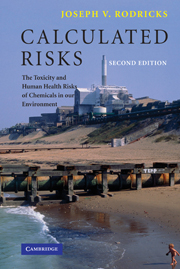Book contents
- Frontmatter
- Contents
- Preface to the first edition
- Preface to the second edition
- List of abbreviations
- Prologue
- 1 Chemicals and chemical exposures
- 2 From exposure to dose
- 3 From dose to toxic response
- 4 Toxic agents and their targets
- 5 Carcinogens
- 6 Identifying carcinogens
- 7 Risk assessment I: some concepts and principles
- 8 Risk assessment II: applications
- 9 Risk assessment III: new approaches, new problems
- 10 Risk assessment IV: the courtroom
- 11 The management of risk
- 12 A look ahead
- Sources and recommended reading
- Index
- Frontmatter
- Contents
- Preface to the first edition
- Preface to the second edition
- List of abbreviations
- Prologue
- 1 Chemicals and chemical exposures
- 2 From exposure to dose
- 3 From dose to toxic response
- 4 Toxic agents and their targets
- 5 Carcinogens
- 6 Identifying carcinogens
- 7 Risk assessment I: some concepts and principles
- 8 Risk assessment II: applications
- 9 Risk assessment III: new approaches, new problems
- 10 Risk assessment IV: the courtroom
- 11 The management of risk
- 12 A look ahead
- Sources and recommended reading
- Index
Summary
In the fall of 1960 thousands of turkey poults and other animals started dying throughout southern England. Veterinarians were at first stymied about the cause of what they came to label “Turkey X disease,” but because so many birds were affected, a major investigation into its origins was undertaken. In 1961 a report from three scientists at London's Tropical Products Institute and a veterinarian at the Ministry of Agriculture's laboratory at Weybridge, entitled “Toxicity associated with certain samples of groundnuts,” was published in the internationally prominent scientific journal, Nature. Groundnuts, as everyone in America knows, are actually peanuts, and peanut meal is an important component of animal feed. It appeared that the turkeys had been poisoned by some agent present in the peanut meal component of their feed. The British investigators found that the poisonous agent was not a component of the peanuts themselves, but was found only in peanuts that had become contaminated with a certain mold.
It also became clear that the mold itself – identified by the mold experts (mycologists) as the fairly common species Aspergillus flavus – was not directly responsible for the poisoning. Turkey X disease could be reproduced in the laboratory not only when birds were fed peanut meal contaminated with living mold, but also when fed the same meal after the mold had been killed.
Chemists have known for a long time that molds are immensely productive manufacturers of organic chemical agents.
- Type
- Chapter
- Information
- Calculated RisksThe Toxicity and Human Health Risks of Chemicals in our Environment, pp. 1 - 10Publisher: Cambridge University PressPrint publication year: 2006



